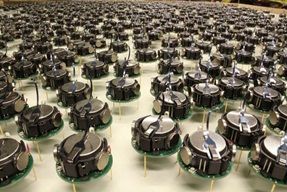The swarm robotics market is projected to grow from USD 0.8 billion in 2023 to USD 3.0 billion by 2028, registering an exciting CAGR of 30.9 % during the forecast period. The market growth is attributed to the rising adoption of swarm-based drones in the military sector and the development of new technologies, such as artificial intelligence and machine learning.
Furthermore, according to researchers at Marketsandmarkets, the increasing use of swarm robotics in warehouses is expected to create lucrative opportunities for the market.
As we might imagine, the military & defence segment is a significant market for swarm robotics, particularly as they often operate in extreme environments. Swarm robotics has applications in defence and security scenarios, including reconnaissance, surveillance, and battlefield operations. Swarms of autonomous robots can be deployed for coordinated missions, target tracking, or perimeter defence.
And according to the analysts findings, in 2022, The US Navy is reportedly working towards making the nightmarish drone swarms seen in Call of Duty and movies like Angel has Fallen a reality in modern combat. Furthermore, in 2023, the US is moving to accelerate the development of autonomous drone swarm technologies through its DARPA AMASS (Autonomous Multi-Domain Adaptive Swarms-of-Swarms) programme, which has proved effective in the ongoing Ukraine war and simulations showing their decisive effect in a Taiwan contingency scenario.
The UGV segment accounted for the largest share of the swarm robotics market in 2022, and a similar trend is expected to be witnessed during the forecast period. The UGV swarm has a number of possible benefits, including preventing injuries by reducing the number of soldiers killed in battle and increasing mobility by allowing the UGV robot to travel to any challenging location that normal humans cannot reach. The increasing usage of this UGV-based swarm robotics in military, agriculture, and other end-use industries is driving the market growth.
Asia Pacific is projected to record the highest CAGR during the forecast period. The demand for AUVs for mine exploration and oceanographic studies has increased significantly in the past few years. In addition, the rising military capabilities of developing nations, such as South Korea and India, are expected to boost the demand for AUVs and drive the swarm robotics market in Asia Pacific. In addition, owing to the internal political tensions, APAC has been witnessing instability, which has propelled the development of UAVs used for border security. This is one of the key factors expected to drive the growth of swarm-based drones in the coming years.








